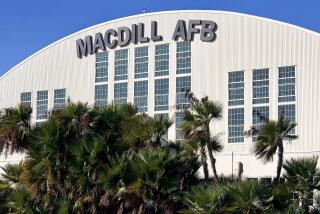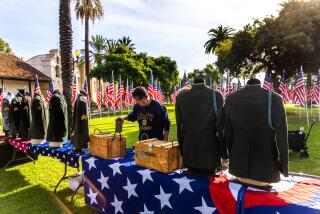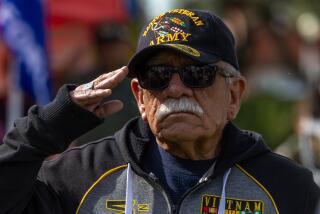Veterans and their loved ones at Fort Rosecrans National Cemetery recall service, sacrifice
At the entrance of Fort Rosecrans National Cemetery, an inscription from a Civil War era poem speaks of those fallen in battle and the duty of the living to never forget their service and sacrifice.
“And Glory guards,” wrote the poet Theodore O’Hara, “with solemn round / the bivouac of the dead.”
For a century and a half, the rolling hills of Point Loma, overlooking San Diego Bay to the east and the Pacific Ocean to the west, have served as such a bivouac: a military cemetery in a military town, a hallowed place of pride and sadness, not just on national holidays, but always.
Photos: Fort Rosecrans National Cemetery
On Monday, for the 111th year, there will be a solemn Memorial Day and Day of Remembrance ceremony here. An admiral will give a decorous speech. A young Marine will read President Lincoln’s Gettysburg Address. A Navy band will play.
The ceremony will be a collective, public experience. Folding chairs will be filled with visitors and VIPs. Television cameras will roll.
But Saturday and Sunday were reserved for individual memories and private visits by family members and others who came to walk amid the 77 acres of graves. Some of the visitors were in animated conversation about their loved one; some spent their time in silence.
Sylvia Black, 73, brought flowers to the grave of her husband, Herbert Scott Black, a Marine wounded in Korea. He was a Marine drill instructor at age 19, “a true leader,” she said. He died in 2005 at age 73.
“I still love him so much,” she said. “I like to bring him flowers. The mourning comes in waves now.”
Some of those buried here died in battle. Most did not. They served in war or peace, returned to their families and lived out their years knowing they had answered their country’s call to duty. Some spent just a few years in uniform, some a career.
But all 100,000-plus share the same distinction.
“They’ve all earned the honor of being here,” said Kirsten Key, 35, visiting the grave of her father, Dennis Kosanke, a Navy veteran who died in 2010 at age 68. “It’s important that we continue to show them the respect they earned.”
Key brings her two sons. “I just like coming down to say hi to my grandpa,” said 8-year-old Garrett Key.
To walk amid the rows of graves is to see the unfolding of American history: battles large and small, some remembered and some forgotten.
There are monuments to the sailors lost in the major sea battles of World War II. And monuments to the Mormon Battalion that arrived in San Diego in 1846 for the war with Mexico, and to the soldiers who fought in the battle of San Pasqual north of San Diego that same year.
The tallest monument, a 60-foot granite obelisk, is for the more than 60 sailors killed in the boiler explosion aboard the gunboat Bennington in San Diego Harbor on July 21, 1905.
Military service, by its nature, is hierarchal and divided into ranks, specialties, and sub-specialties. But there is an equality in death: Medal of Honor recipients and famous officers are buried beside the seamen, airmen, foot soldiers and “grunts” who fill out the ranks and are but lightly mentioned, if at all, in military history.
The inscriptions on the gravestones speak of service and comradeship: “Semper Fi.” “Always A Marine.” “Promoted to Glory.” “Together Forever.” “You Made Us All Better.” “Till We Meet Again Mizpah.” “On The Road Less Traveled.” “Served With Pride.”
There are some with a touch of humor. “Just Resting My Eyes.” “Top Dog on the River.” “It’s Martini Time My Love.”
On Saturday, the weather was balmy, and the tall trees had only a slight murmur. On Sunday, a cold, persistent wind made the trees bend and the flags whip and snap — but nothing deterred the visitors.
Cheri Woods, 49, came to honor her husband, David Woods, an enlisted sailor who died in 1994 from an off-duty accident.
“He was only 34,” Woods said. “But you look around here, and you find ones that were even younger. It’s so beautiful here — and so sad.”
Darlene Holland, 78, came to put roses clipped from her garden on the grave of her stepson, George Holland, an Air Force master sergeant who served in Vietnam and died in 1990 at age 45. “We think it was Agent Orange,” Holland said.
Teenagers organized by the Rancho Bernardo Lions Club placed wreaths on the graves of 67 personnel killed in Iraq or Afghanistan.
As the cemetery has aged, new burials have been restricted to ashes placed in the columbarium walls. Casket burials are allowed only for those killed in recent combat.
Marine Maj. Ray Mendoza, killed while leading his Marines into battle in Iraq in 2005, is buried here. A few graves away is his best friend, Maj. Richard Gannon, who was killed in Iraq a year earlier. Before Mendoza deployed, he had instructed that if he was killed, he wanted to be buried near Gannon.
Navy SEAL Michael Anthony Monsoor, posthumous recipient of the Medal of Honor for bravery in Iraq in 2006, is buried here. His epitaph: “No Regrets.” SEALs from the base in Coronado keep his grave fresh with flowers year round.
Navy Lt. Florence Choe, who volunteered to go to Afghanistan to help develop a hospital for Afghan civilians and military, is buried here. She was killed by an insurgent masquerading as an Afghan soldier in 2009.
Cemetery rules allow family members to be buried in the same location as the veteran, either in a casket space or a columbarium space.
“I’ll be here someday,” said Lucille Lofgren, 82, as she placed two orchids on the grave of her husband, Earl W. Lofgren , who died in 2005 at 85. “He did 32 years in the Navy, a good man, a good Navy man.”
For this weekend, 66,000 small flags were placed on the graves by Boy Scouts, Girl Scouts, and other volunteers. Though the cemetery’s focus is the service of military veterans of the past, its tree-shaded location provides a panoramic view of today’s military.
Navy ships can be seen gliding toward the ocean, maybe deploying to the Persian Gulf or another trouble spot. Warplanes are seen — and heard — on the runways of Coronado’s North Island Naval Air Station. In the city below the hills is the Marine boot camp.
The rows of graves led Al Cocumelli, 89, who served in the Army in World War II and Korea, to remember the battles at Guadalcanal and the Philippines — images he does not want to remember but does not want to forget either.
“I buried five friends with my hands,” Cocumelli said as he gazed at the graves on a hill facing the ocean. “People don’t know what it’s like to reach into your pack, get a small shovel and then bury a friend killed in battle.
“They should come here and think about those things.”
Photos: Fort Rosecrans National Cemetery
More to Read
Start your day right
Sign up for Essential California for news, features and recommendations from the L.A. Times and beyond in your inbox six days a week.
You may occasionally receive promotional content from the Los Angeles Times.






